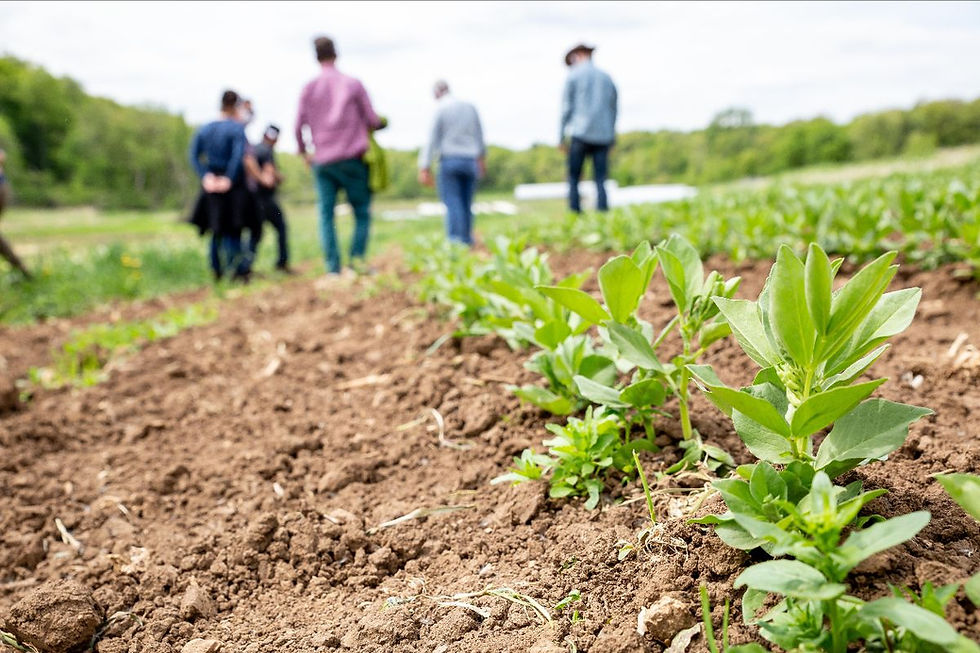Supporting HMoob Growers During AAPI Heritage Month and Beyond
- Chiang Rai Lor

- May 20, 2024
- 4 min read

May is National Asian American & Pacific Islander (AAPI) Heritage Month. To celebrate, we sat down with our Aggregation Coordinator, Chiang Rai Lor, for a Q & A on the history of HMoob growers in the state, current challenges they are facing, and how we can continue to support their success into the future.
A note on terminology: Why HMoob instead of Hmong? HMoob is a more inclusive spelling that represents the different dialects of the HMoob language and the diversity of the HMoob people. “HMoob” is pronounced identically to “Hmong.” Learn more here.
Q: Can you start by giving us a brief history of HMoob growing practices?
A: Traditional HMoob growing practices reflect the growing practices originating in Laos, where there is high elevation and two seasons: dry, and rainy. Many growers we work with today still use the same traditional hand tools used in Laos. HMoob farmers in Laos utilized slash and burn farming, clearing the farm with fire and leaving the ashes to fertilize the soil. Once the ground was ready, they would dig, grab a handful of seeds, toss in the hole, wait for rain, weed daily, and wait for harvest. The majority of HMoob growers in the United States are refugees who arrived from Laos and continue to use many of these traditional growing methods today. Wisconsin has the third largest HMoob population in the United States!

Q: What are some of the challenges facing HMoob growers that you see come up in your work?
A: There are a few challenges that come directly from the traditional practices we just discussed. Because HMoob growers in Laos moved around more frequently (slash and burn agriculture kept the soil fertile for only about three years) there isn’t as much knowledge around crop rotation and using cover crops to maintain soil health. The traditional tools used aren’t very efficient, and many HMoob growers either aren’t aware of or don’t have access to more modern and efficient tools and machinery. And the traditional way of planting (not counting seeds when planting) isn’t as effective because growers don’t know the success rate of their seeds.
Overall, because many HMoob farmers are used to farming in such a labor intensive way, most growers would rather spend hours in the field rather than invest in machinery to cut time - there is less of a sense of value on their time and physical health.
Q: And are there more systemic challenges as well?
A: Absolutely. Many HMoob growers sell primarily at farmers’ markets (about 20% of vendors at the Dane County Farmers’ Market, the largest producer-only market in the country, are HMoob). They get a higher price per item at the market and the barrier to entry is lower than other market channels. Selling to a grocery store, restaurant, or wholesale has many more barriers that can make it difficult.
Record keeping, post-harvest handling, financial management, farm business planning, and infrastructure are all things that need to be addressed if HMoob growers want to expand their market access. And there are also language barriers and land access issues that come into play.
Q: What are some of the opportunities you see in your work with HMoob growers?
A: Many growers are starting to focus on infrastructure needs (refrigeration, transportation, etc), and there’s a lot of interest and movement around land access for HMoob growers. There is also a lot of interest in expanding market access (like adding wholesale) but the requirements can be a barrier and actually end up disincentivizing growers from trying.
What I have noticed is that there is often a hesitation to give up farmers’ market to try something like wholesale because the price point at market is higher and growers don’t want to give up their market spot for a new venture that may be less lucrative. So finding ways to add market avenues, rather than replacing, feels like a really exciting opportunity. And providing the training and resources needed to make those adjustments is a great way to support that.
A good example of this is the Local Food Purchasing Assistance Program (LFPA) which focuses on providing educational training and a wholesale market for socially disadvantaged and underserved communities. Being able to connect HMoob growers to the program and supporting them through the process with wholesale training, addressing the pros and cons of selling from farmers' market to wholesale, and building awareness around other market opportunities is a step forward in changing the way HMoob growers manage their farm business.

Q: What do you think is needed to make this work successful?
A: I have really strong partnerships that I can draw from, which feels critical. Not only within FairShare in our grower team, but also across organizations. Working with folks at Groundswell Conservancy, UW-Extension, Marbleseed, GreenGold Gardens, Fondy Food, Big River Farms, WI Food Hub Cooperative, and Wisconsin Department of Agriculture, Trade & Consumer Protection ensures that programs are reflecting the needs of the community as a whole, while drawing on specific areas of expertise at each organization.
And, of course, building meaningful relationships with growers, which takes time. I’ve noticed that it is important for our growers to have an example in the HMoob community that they can see and draw from. In the end, while we offer one-to-one assistance in many aspects, all we are really doing is providing information and support - the growers are the ones that will be implementing the practices. And having strong relationships and community support is really important in making that happen.





Comments